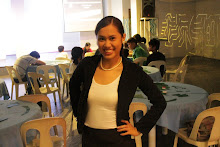In our
everyday walk, we encounter people of prominence. We find them on newspapers,
see them on television and hear them talk over the radio. For Julius Sagrado,
these personalities made an impact in his life. Yet, it is up for you to decide
whether or not they have wronged you.
Last
March 27, 2012, Sagrado debuted his first solo art exhibit which he entitled Paskin.
This is a Cebuano word which means banner or billboard. This exhibit is his
entry point to being a professional artist and his exit to his student life in
the University of the Philippines (UP) as his thesis into finishing his
Bachelor’s degree in Studio Arts.
 |
| Julius Sagrado speaks about Paskin |
This
thesis however, is unlike no other. Sagrado together with his classmate
Ebenezar Morrok, made their theses in our own Cebuano language. Mentor and Fine
Arts professor Raymund Fernandez was proud to have his own students use their
native tongue in writing their research paper. “Dili naman gani ko maka antigo og Bisaya, kay anad man kog English sa
eskwelahan. (I can’t even speak Cebuano fluently because English is used in
the academe),” Fernandez said noting that his students made him realize the
beauty of this language.
According
to Sagrado, Paskin was guided by different kinds of observers from the society.
These images are parts of our community that we always see due to good news or
a controversy. But the artist leaves the decision to the viewers whether or not
to judge these images on the good side. He wanted to bring back the importance
of the banner or karatola which
brings the public information.
 |
| Boxing Champ is his "Kampilan" |
The
titles of his paintings on canvass are the objects that fascinated him during
his childhood that remain in his memory until now that somehow relate to the
prominent person. For instance Manny Pacquiao’s image was titled as Kampilan; Former President Gloria’s as Tugnaw; and Chief Justice Renato
Corona’s as Tabon.
According
to Humanities Professor Ligaya Rabago – Visaya, Paskin is an exhibit that
“needs a viewer who is very critical about society, particularly the Philippine
society.” Because of the prominence of the people in these paintings, one needs
to scrutinize properly their role in our society today.
Sagrado
used subtle colors on the subject such as grey, lavender and beige which he
blended very carefully to create a slightly distorted image. For the
background, he used bright pastel colors to let the subject stand out. He said
that this is a pop art technique which he learned from the artist which made
this movement famous, Andy Warhol.
The set of paintings were not done with
ordinary paint. Sagrado integrated his love for printing t-shirts on the
canvass by using silk screen techniques. He also used galvanized iron roof,
automotive paint and newspapers to create a single image. Talk about the
diversity in medium!
 |
| His Favorite in his set entitled "Bol" |
When
asked of his favorite work in his set, he pointed to his own rendition of the
former president Erap Estrada. “Ang slogan ni Erap kay Erap para sa mahirap.
Daghan man daw siya’g nabuhat pero para nako wala gyud kaayo. (Erap’s slogan
was Erap para sa mahirap. They said he did a lot of things for our country but
for me, there was none). He also explained that out of the eight paintings,
Erap’s face was the one closest to the real Erap. It was also unique because it
was not a rectangular canvass but a circular one, a rare in paintings.
Vienne
Fortalejo, a product design major in the same university, said that the
paintings look simple at first glance. “However, the process is hard that due
to the different layers of paint used it becomes real to me and I guess to the
rest of the viewers as well,” she added.
 |
| Who says she's only in the Senate?
**Published in the Sun.Star Newspaper last April 3, 2012
|
Simple
as it may seem, all that Sagrado wants is to raise the banner higher for people
to see the reality amidst the controversies going on.

0 comments:
Post a Comment